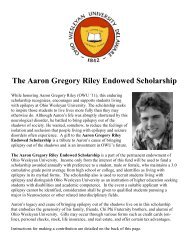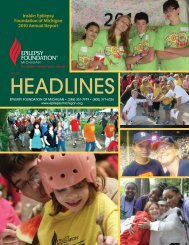Legal Rights of Children with Epilepsy in School & Child Care
Legal Rights of Children with Epilepsy in School & Child Care
Legal Rights of Children with Epilepsy in School & Child Care
You also want an ePaper? Increase the reach of your titles
YUMPU automatically turns print PDFs into web optimized ePapers that Google loves.
<strong>Legal</strong> <strong>Rights</strong> <strong>of</strong> <strong><strong>Child</strong>ren</strong> <strong>with</strong> <strong>Epilepsy</strong> <strong>in</strong> <strong>School</strong> and <strong>Child</strong> <strong>Care</strong><br />
Greer v. Rome City <strong>School</strong> District, 950 F. 2d 688 (11 th Cir. 1991)<br />
The Eleventh Circuit adopted the two-part Daniel R.R. test and found that the district<br />
failed to accommodate the student appropriately <strong>in</strong> a regular classroom. The court held<br />
that before a district may decide to remove a student from the regular classroom, it must<br />
consider whether supplemental aids and services can permit satisfactory education <strong>in</strong> the<br />
regular classroom; it must consider the full range <strong>of</strong> supplementary aids and services. The<br />
court outl<strong>in</strong>ed a non-exhaustive list <strong>of</strong> factors to be considered, <strong>in</strong>clud<strong>in</strong>g the comparative<br />
benefits <strong>of</strong> the regular versus the special education classrooms, the effect <strong>of</strong> the child<br />
<strong>with</strong> a disability on the rest <strong>of</strong> the children <strong>in</strong> the regular classroom, and the cost <strong>of</strong> the<br />
supplementary aids and services that would be necessary for the child <strong>with</strong> a disability to<br />
obta<strong>in</strong> a satisfactory education <strong>in</strong> the regular classroom.<br />
Oberti v. Board <strong>of</strong> Education <strong>of</strong> Borough <strong>of</strong> Clementon, 995 F.2d 1204 (3d Cir. 1993)<br />
In hold<strong>in</strong>g that a district failed to make adequate efforts to <strong>in</strong>clude a child <strong>with</strong> Down<br />
Syndrome <strong>in</strong> regular education, the Third Circuit adopted the Daniel R.R. test, hold<strong>in</strong>g<br />
that the court should first ask whether a student can be educated satisfactorily <strong>in</strong> a regular<br />
class <strong>with</strong> supplemental aids and services and then, if not, whether the school has<br />
<strong>in</strong>cluded the child <strong>with</strong> non-disabled children to the maximum extent appropriate. In<br />
ask<strong>in</strong>g the first question, the court should consider a) whether the school district has<br />
made reasonable efforts to accommodate the child <strong>in</strong> a regular classroom, b) the<br />
educational benefits available to the child <strong>in</strong> a regular class <strong>with</strong> appropriate<br />
supplementary aids and services, compared <strong>with</strong> the benefits available <strong>in</strong> a special<br />
education class, and c) the possible negative effects <strong>of</strong> the child’s <strong>in</strong>clusion on the<br />
education <strong>of</strong> the other students <strong>in</strong> the class. When address<strong>in</strong>g the second question, the<br />
court noted, the school district should take <strong>in</strong>termediate steps when appropriate, such as<br />
<strong>in</strong>clud<strong>in</strong>g the child <strong>in</strong> nonacademic classes or other activities.<br />
Sacramento City Unified <strong>School</strong> District v. Holland, 14 F.3d 1398 (9 th Cir. 1994)<br />
The N<strong>in</strong>th Circuit affirmed an <strong>in</strong>clusive educational placement for a student <strong>with</strong> mental<br />
retardation and adopted a four-factor test that blended elements <strong>of</strong> the Daniel R.R. and<br />
Roncker standards. The court held that the follow<strong>in</strong>g must be considered <strong>in</strong> determ<strong>in</strong><strong>in</strong>g<br />
placement: a) the educational benefits <strong>of</strong> full-time placement <strong>in</strong> a regular class; b) the<br />
nonacademic benefits <strong>of</strong> full-time placement <strong>in</strong> a regular class; c) the effect the child <strong>with</strong><br />
a disability has on the teacher and other children <strong>in</strong> the regular class; and d) the costs <strong>of</strong><br />
<strong>in</strong>clud<strong>in</strong>g the child <strong>with</strong> a disability <strong>in</strong> the regular class.<br />
Beth B. v. Van Clay, 282 F.3d 493 (7 th Cir. 2002)<br />
The Seventh Circuit decl<strong>in</strong>ed to adopt a test for decid<strong>in</strong>g least restrictive environment<br />
cases. The court found the IDEA’s framework sufficient, stat<strong>in</strong>g that if the student’s<br />
placement was satisfactory, the district would be <strong>in</strong> violation <strong>of</strong> the statute by remov<strong>in</strong>g<br />
her and, if not, the district’s recommended placement would not violate the statute if the<br />
placement ma<strong>in</strong>streamed her to the maximum extent appropriate.<br />
62








